Price: $17
Black Live Matter Coffee Mug
11 oz Mug
Start your day off right with an artful coffee mug made just for you.
Offered at $17
Back to Art for Sale
Price: $17
Black Live Matter Coffee Mug
11 oz Mug
Start your day off right with an artful coffee mug made just for you.
Offered at $17
Back to Art for Sale
SOLD
Flowers Store
by Andrew Turner
Size 12″ x 15″ Approx
Andrew Turner was born in l944 in Chester, Pennsylvania. He was a graduate of Temple University’s Tyler School of Art. Andrew’s work has been widely acclaimed, with many solo exhibitions and participation in group exhibitions. He has taught art in grades K-1 2 in the Chester, Pennsylvania Public Schools and in correctional centers. His appointments include Artist-in-Residence and Curator, Deshong Museum, Chester, PA; Lecturer, Widener University; Lecturer, Institute of Contemporary Art, University of Pennsylvania, Philadelphia, PA; and, he toured and lectured in The People’s Republic of China. Collections which hold Andrew’s paintings include Woody Allen, Dr. Maya Angelou, ARCO Chemical Company, Bell Telephone Company, Dr. Constance Clayton, Mr. and Mrs. Bill Cosby, Edie Huggins, Eric Lindros, Mr. and Mrs Louis Madonni, Moses Malone, Penn State University, the artist formerly known as Prince, Mr. and Mrs. Harold Sorgenti, Swarthmore College, Mrs. Marilyn Wheaton, and Widener University Deshong Museum, just to name a few. He has been featured in numerous solo exhibitions and group exhibitions in the United States and abroad. His Philadelphia commissions include: WDAS FM (1996); Marco Solo, (published by J. Schwinn and G. Harlow, illustrated by Andrew Turner) Reverse Angle Productions, Inc. (I 995); and Robin Hood Dell, Fairmount Park (1985).
“My paintings combine the drama inherent in seventeenth century Dutch painting with the brush work and the economy of the Impressionists. However, I look to the jazz idiom more so than to other contemporary visual artists for guidance and inspiration. I tend to measure the success of my pieces by how they stand up technically, emotionally and innovatively to a Coltrane solo or whether I’ve captured the spirit of the occasion, a la Ellington. The subject matter, sometimes nostalgic recollections of my days as a young tough, covers a myriad of common folk activities. The setting usually my native Chester, is a beehive of creative stimulation or a deteriorating ghetto depending on my state of mind. At the very least, hopefully, these vignettes of experience will help to provide insight into some African American lifestyles and serve as an inspiration to my students and others to continue the legacy of African American participation in the arts.”
Andrew Turner 1944 – 2001
SOLD
Dark Sweet Night
by Andrew Turner
Original Acrylic on Board
Size 36″ x 44″ Approx
Andrew Turner was born in l944 in Chester, Pennsylvania. He was a graduate of Temple University’s Tyler School of Art. Andrew’s work has been widely acclaimed, with many solo exhibitions and participation in group exhibitions. He has taught art in grades K-1 2 in the Chester, Pennsylvania Public Schools and in correctional centers. His appointments include Artist-in-Residence and Curator, Deshong Museum, Chester, PA; Lecturer, Widener University; Lecturer, Institute of Contemporary Art, University of Pennsylvania, Philadelphia, PA; and, he toured and lectured in The People’s Republic of China. Collections which hold Andrew’s paintings include Woody Allen, Dr. Maya Angelou, ARCO Chemical Company, Bell Telephone Company, Dr. Constance Clayton, Mr. and Mrs. Bill Cosby, Edie Huggins, Eric Lindros, Mr. and Mrs Louis Madonni, Moses Malone, Penn State University, the artist formerly known as Prince, Mr. and Mrs. Harold Sorgenti, Swarthmore College, Mrs. Marilyn Wheaton, and Widener University Deshong Museum, just to name a few. He has been featured in numerous solo exhibitions and group exhibitions in the United States and abroad. His Philadelphia commissions include: WDAS FM (1996); Marco Solo, (published by J. Schwinn and G. Harlow, illustrated by Andrew Turner) Reverse Angle Productions, Inc. (I 995); and Robin Hood Dell, Fairmount Park (1985).
“My paintings combine the drama inherent in seventeenth century Dutch painting with the brush work and the economy of the Impressionists. However, I look to the jazz idiom more so than to other contemporary visual artists for guidance and inspiration. I tend to measure the success of my pieces by how they stand up technically, emotionally and innovatively to a Coltrane solo or whether I’ve captured the spirit of the occasion, a la Ellington. The subject matter, sometimes nostalgic recollections of my days as a young tough, covers a myriad of common folk activities. The setting usually my native Chester, is a beehive of creative stimulation or a deteriorating ghetto depending on my state of mind. At the very least, hopefully, these vignettes of experience will help to provide insight into some African American lifestyles and serve as an inspiration to my students and others to continue the legacy of African American participation in the arts.”
Andrew Turner 1944 – 2001
Offered at $SOLD
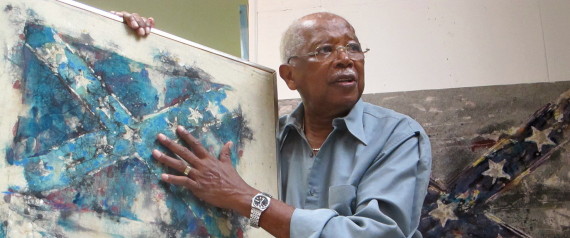
ORANGEBURG, S.C. (AP) — Leo Twiggs’ paintings of shadowy Confederate flags and faceless men with bulls-eyes on their backs are a few of the haunting images he has developed living as a black man in the South.
The 80-year-old South Carolina artist says he hopes the works, which some may see as divisive, spark thoughtful reactions and help people understand their shared history, even for those outside the South.
“This Confederate flag, the Civil War, they are part of the history of all of us,” Twiggs said. “You take the stars off the bars, and it becomes a cross, maybe a railroad crossing. It can become a crossing over, something that we commemorate, and something we can cross over.”
Jovial and chatty at his Orangeburg studio, Twiggs said he is enjoying his best year as an artist. He’s had more than 70 solo shows over his career, and three new shows recently opened in his home state in Myrtle Beach, Greenville and Taylors.
Two of them highlight his use of Confederate flags — red, white, or blue smudged with brown or blood-red splotches. In several, the outlines of brown figures float in the background. Many flags are tattered, looking tired and rough. A black cow stands watch in some, recalling an animal Twiggs cared for as a child, growing up in segregated St. Stephens.
“We were poor, but we had dignity,” Twiggs said. “Ours was a struggle that speaks to a struggle experienced by all mankind.”
Sandy Rupp, owner of the Hampton III Gallery in Taylors, said Twiggs has been exploring flag images since the 1970s.
“He’s not trying to divide everybody,” Rupp said. “He sees it as a historic symbol, a symbol of white supremacy that he makes into his own. He makes it his flag, and gives it his power.”
As the aroma of hot wax fills the room, Twiggs uses a metal pen-like tool to drip warm wax on a rough piece of fabric. He colors it with hand-mixed vegetable dyes, and then removes the wax with an iron, repeating the process over and over. It takes up to a month to complete each composition.
William Eiland, director of the Georgia Museum of Art at the University of Georgia in Athens, said for many in the South, the flag represents “an unrepentant South, perhaps a South rising again.”
“But Leo takes that image and lets it mutate, change, degrade, adapt, into an image that becomes part of his experience,” Eiland said.
Other themes fill Twiggs’ work — the rebel flag morphs into a white railroad crossing sign, which divides many rural Southern towns; black ancestral mothers pose in their Sunday best; white boss men in wide-brimmed hats stand over ghostly black and white figures; white strings of hurricane-force winds whip bodies in a storm.
Twiggs said his “Targeted Man” series of faceless men bearing bulls-eyes harkens back to the Ku Klux Klan using white robes and burning torches “to try to scare us.” But once the nation came under attack in the Sept. 11 terrorist strikes, Twiggs said he realized the images also meant, “we are all targeted, we all have things to fear.”
Follow Susanne M. Schafer on Twitter at http://twitter.com/susannemarieap![]()

Price: $17
Love Is Coffee Mug
11 oz Mug
Start your day off right with an artful coffee mug made just for you.
Offered at $17
SOLD OUT
Love Is Hearts Postcard Magnet
Size 5.25″ x 4.25″
Beautiful Artful Large Fridge Magnets
*We’ll pay you for all clicks you generate, earn $0.20 per visitor. Unique visitor.
*We’ll pay you for all signups for our News Letter you generate on your webpage-unique signups – earn $0.50 per sign up.
Note: If you wish to send an email blast (event notice – special program – a note from you)
just to folks that signed up from your page we can do this.
*We’ll pay you 10% on all sales directly from your efforts on our website and at the gallery.
*Bring a client to the gallery and they buy – 10% to you.
Affiliate Videos and Audio Notes
Define print/poster: click here
Art Class: click here
Artful film: click here
Collecting Black Art: click here
Black Art Industry: click here
Art Education 101: click here
Post to our facebook page: click here
Read our book online: click here
Use these banners/images on facebook or your email blast.
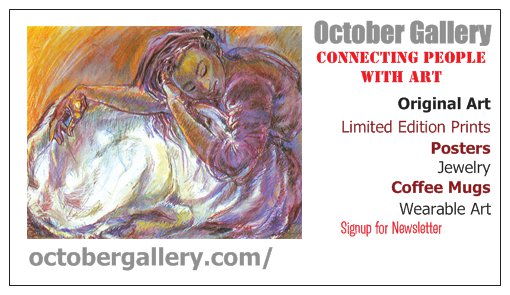
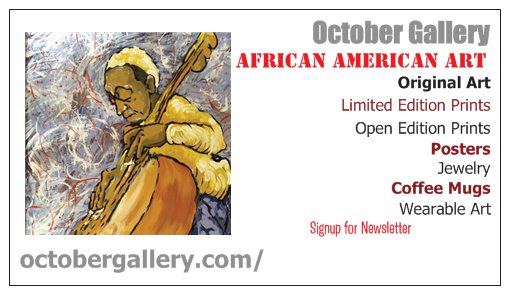
Post this video to facebook, your email, your website or webpage
then link it to your October Gallery web page
Link to video: https://youtu.be/0ABO2v3JF9E
Post this video to facebook, your email, your website or webpage
then link it to your October Gallery web page
Link to video: https://youtu.be/8wEsEF06eRg
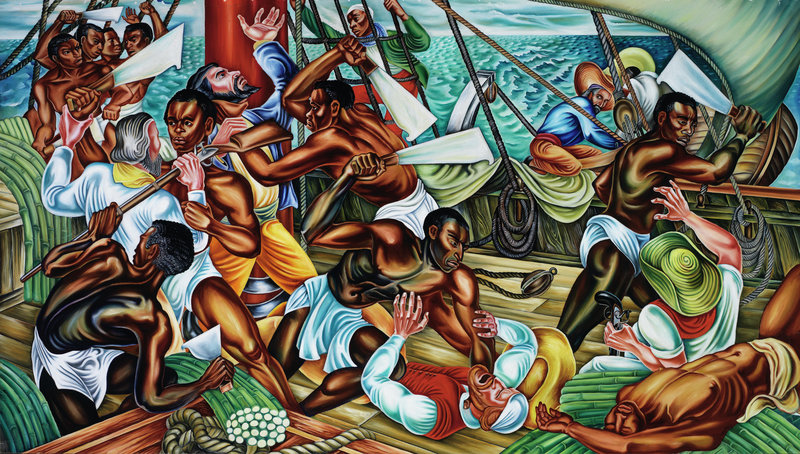
Artist Hale Aspacio Woodruff was commissioned to paint the Amistad Murals in 1938.
Peter Harholdt/Copyright Talladega College
Most Americans know little about the painter Hale Woodruff, but he had a profound influence on 20th century American art. Like many black artists in the 1920s, Woodruff left the country for Paris. He later studied in Mexico with Diego Rivera.
Today Woodruff is best-known for a set of murals at Talladega College in Alabama. After a national tour, those murals have made a final stop in Kansas City, where Woodruff’s family has roots.
Shawn Hughes, Woodruff’s great nephew, stands in the Nelson-Atkins Museum of Art, surrounded by giant paintings in vivid colors with nearly life-sized figures. On one wall, a deck full of slaves is about to mutiny on the Amistad. On another wall, an urgent scene in the woods, as slaves are about to cross the Ohio River to freedom.
In the second mural, the trial of the Amistad mutineers, is a man in a green shirt in the crowd. It’s a self-portrait of Hughes’ great uncle, Hale Woodruff.
“He always puts his image in his works,” Hughes says.

In this 1939 mural, Woodruff depicts the trial of the Africans aboard the Amistad.
This exhibition was organized by the High Museum in Atlanta back in 2012. Hughes has been to see the murals in New York and Washington, D.C., as well. Woodruff died when Hughes was a young man.
“He was a very sophisticated man,” Hughes says. “Our family was very outgoing and gregarious, but he was very reserved, very quiet. I mean, he had an awesome presence about him.”
At Atlanta University, Woodruff founded what was known as the Exhibition for African American artists.
Library of Congress, Prints & Photographs Division, FSA/OWI Collection
Growing up in Kansas City, Hughes knew about the famous muralist Thomas Hart Benton, who lived and taught there. And he learned about the European painters in high school. But he didn’t learn about his great uncle’s importance until he went to Fisk University in Nashville.
“First day I walk into the library. And as I walk into the library I look to my right, and they had a huge exhibit on Uncle Hale,” Hughes says. “I was so excited about it I ran back to the dorm, called my mother collect, and I said, ‘Mom, Mom, they got an entire corner dedicated to Uncle Hale.’ She said, ‘Yeah, now I want you to get off this phone and go read every book, and learn not only about him but learn about Aaron Douglas and the many other great African-American artists that are in the world.'”
Woodruff was a pioneer, says David C. Driskell, a distinguished art professor emeritus at the University of Maryland-College Park. Woodruff was one of the major art teachers at historically black colleges and universities at a time when there weren’t that many people in that discipline, says Driskell.
In 1942, when Woodruff was at Atlanta University, he founded what was known as the Exhibition for African American artists. It “was the only venue where people of color could exhibit on a national scale without the forces of segregation,” Driskell explains.

In his 1942 mural The Underground Railroad, Woodruff shows slaves about to cross the Ohio River to freedom.
This was a place where black artists could compete and have their work judged by a mixed jury of blacks and whites. Major artists like Romare Bearden, Jacob Lawrence and many others considered Woodruff a mentor.
“By bringing subjects of importance relating to the African-American experience to the American art canon, he was very much bent on helping to tell the history of African-Americans by painting murals,” Driskell says.
Hughes organized another exhibition across town in the art gallery at the American Jazz Museum. This exhibition includes black-and-white prints and Christmas cards Woodruff painted for his relatives, abstract paintings and some of his black and white prints. Curator Sonié Joi Thompson-Ruffin says Woodruff deserves two concurrent exhibitions.
“Now, you can’t get enough black,” she says. “Now, you can’t get enough African-American art. We are now considered American artists. This is the man that paved the way.”
By the time Woodruff died in 1980 he was recognized by his peers in the art world. But he had a warning for his great nephew and niece.
Hughes remember sitting at Woodruff’s feet. “He would draw something, my sister and I would be there drawing. He would tell us, yeah you guys got talent but it’s not going to do you any good. He said, ‘My paintings are not going to make any matter. The only thing it’s going to do — it’ll be worth something to you guys. He drilled that into my mom’s head. He said, ‘Yeah, they’re really talented artists in their own right, but send ’em to law school.”
Woodruff was wrong about one thing. His paintings did matter.

Here, Woodruff portrays the repatriation of freed slaves in Africa.

DETROIT — Can an exhibition be informed by the place it visits? 30 Americans, a survey of works by African American artists in the Rubell Family Collection, which debuted in Miami, and has since visited places including the Milwaukee Art Museum, stands on its own as a remarkable assortment of contemporary voices — but in the context of Detroit and the Detroit Institute of Arts, these voices take on a whole new tenor. Though some have been critical of the collector-driven nature of the show, the Detroit Institute of Arts devoted substantial time and resources to researching the exhibit, in terms of its impact, interpretation, and reception among Detroiters, conducting focus groups with the interest of making the material accessible to museumgoers.
I happened to be a member of one such focus group, and some of the commentary and questions posed by participants regarding their comfort level with racially-charged (or just racially-focused) subject matter offered an eye-opening glimpse into the DIA’s struggle to expand perspectives and conversations in a city that has remained deeply divided along racial lines. Detroit is the city with the largest majority black population in the country, and it is significant to see a recent effort on the part of arts organizations to diversify their programming in a way that reflects these demographics. By the standards of the surrounding Metro Detroit communities, the work shown in 30 Americans is controversial.Kara Walker is a household name in most urban art centers; the DIA acquired one of her pieces in 1996 since 1996, but has never put it on public display. The piece itself is comparatively tame with respect to “Camptown Ladies,” which dominates two entire walls at the heart of 30 Americans.
This queasiness in dealing with some of the harsher realities of historic (and contemporary) race relations in the region has lately been addressed with projects like Nick Cave’s much-lauded citywide happening “Here Hear” sponsored by Cranbrook Art Museum (Cave is also one of the artists represented within 30 Americans). But while Cave’s work can be construed as whimsical despite its serious conceptual underpinnings, 30 Americans really tackles some of the hardest aspects of the brutal legacy of slavery in our country, and the suppression of the African American voice, in myriad forms.
Works in 30 Americans include “Duck, Duck, Noose,” (1992) by Gary Simmons — where the children’s game is transformed into a circle of chairs topped with Klan hoods, the eponymous noose awaiting whoever ends up in the middle; “The Great White Way, 22 Miles, 9 Years, 1 Street” (2001–2002), a digital video process piece and statement on homelessness wherein artist William Pope.L, wearing a Superman costume, dragged himself on his stomach down the full length of Manhattan, incrementally over the course of nine years; and “Branded Head” (2003) by Hank Willis Thomas, which showcases the Nike swoosh — a symbol tied inextricably to the racially loaded world of professional sports — that both literally and figuratively brands the head of an unidentified black male subject. From a bundle of suspended feathers and clothing bearing Tupac’s face, as though hung upside-down, to a towering wall of cotton bales, 30 Americans is not pulling any punches, and in hosting this challenging assortment of works, the DIA is demonstrating a heretofore unseen level of willingness to bring these issues to light among the Detroit Metro populace.

More normative perspectives are also present in 30 Americans — as the show’s title would suggest, the point is not necessarily to emphasize the other-ness of African American people, but their identity as Americans. In terms of connecting with its immediate community, this may be the first time the DIA has featured a show wherein the racial demographics of the depicted subjects more or less accurately reflect the racial demographics of the city. Who you see on the walls sends a powerful message about who is welcome in the galleries, and 30 Americans stands as a clear appeal on the part of the DIA to court its city population as a desired base of attendance. This effort was reinforced by the opening night community celebration, which featured playful local touches like Faygo pop and a performance by rising local star Tunde Olanrian, whose dramatic showmanship and inspirational musical message have him poised to break atmosphere and take the country by storm (presumably accompanied, as always, by his two synchronized and utterly deadpan female backup dancers).
Was the DIA’s handling and interpretive treatment of 30 Americans executed flawlessly? It received mixed reviews, but to lambast the museum’s intentions — as did Tyler Green, in a series of tweets focused on the politics of allowing collectors such a large role in presenting works they own — is to miss the intended audience of 30 Americans, Detroiters who have never before set foot in the DIA. The loudest critics of the DIA’s exhibition design were, in the end, perhaps not those for whom it was intended.

Exhibitions like 30 Americans could have the potential to amplify conversations about race within Detroit, while helping to demonstrate a meeting between its communities and one of its longstanding institutions, and to write off that effort as a shell game on the part of the Rubells or a misstep by the DIA is giving it short shrift. Detroit is not the only city that has hosted 30 Americans, but it could be one of the most important.
30 Americans continues at the Detroit Institute of Arts (5200 Woodward Ave, Detroit) through January 18.
SOLD
Our Supper
by Andrew Turner
Original Acrilic on Board
Size 29″ x 25″ Approx
Andrew Turner was born in l944 in Chester, Pennsylvania. He was a graduate of Temple University’s Tyler School of Art. Andrew’s work has been widely acclaimed, with many solo exhibitions and participation in group exhibitions. He has taught art in grades K-1 2 in the Chester, Pennsylvania Public Schools and in correctional centers. His appointments include Artist-in-Residence and Curator, Deshong Museum, Chester, PA; Lecturer, Widener University; Lecturer, Institute of Contemporary Art, University of Pennsylvania, Philadelphia, PA; and, he toured and lectured in The People’s Republic of China. Collections which hold Andrew’s paintings include Woody Allen, Dr. Maya Angelou, ARCO Chemical Company, Bell Telephone Company, Dr. Constance Clayton, Mr. and Mrs. Bill Cosby, Edie Huggins, Eric Lindros, Mr. and Mrs Louis Madonni, Moses Malone, Penn State University, the artist formerly known as Prince, Mr. and Mrs. Harold Sorgenti, Swarthmore College, Mrs. Marilyn Wheaton, and Widener University Deshong Museum, just to name a few. He has been featured in numerous solo exhibitions and group exhibitions in the United States and abroad. His Philadelphia commissions include: WDAS FM (1996); Marco Solo, (published by J. Schwinn and G. Harlow, illustrated by Andrew Turner) Reverse Angle Productions, Inc. (I 995); and Robin Hood Dell, Fairmount Park (1985).
“My paintings combine the drama inherent in seventeenth century Dutch painting with the brush work and the economy of the Impressionists. However, I look to the jazz idiom more so than to other contemporary visual artists for guidance and inspiration. I tend to measure the success of my pieces by how they stand up technically, emotionally and innovatively to a Coltrane solo or whether I’ve captured the spirit of the occasion, a la Ellington. The subject matter, sometimes nostalgic recollections of my days as a young tough, covers a myriad of common folk activities. The setting usually my native Chester, is a beehive of creative stimulation or a deteriorating ghetto depending on my state of mind. At the very least, hopefully, these vignettes of experience will help to provide insight into some African American lifestyles and serve as an inspiration to my students and others to continue the legacy of African American participation in the arts.”
Andrew Turner 1944 – 2001
SOLD
Flowers Vase
by Andrew Turner
Acrilic on Paper
Size 29″ x 33″ Approx
Andrew Turner was born in l944 in Chester, Pennsylvania. He was a graduate of Temple University’s Tyler School of Art. Andrew’s work has been widely acclaimed, with many solo exhibitions and participation in group exhibitions. He has taught art in grades K-1 2 in the Chester, Pennsylvania Public Schools and in correctional centers. His appointments include Artist-in-Residence and Curator, Deshong Museum, Chester, PA; Lecturer, Widener University; Lecturer, Institute of Contemporary Art, University of Pennsylvania, Philadelphia, PA; and, he toured and lectured in The People’s Republic of China. Collections which hold Andrew’s paintings include Woody Allen, Dr. Maya Angelou, ARCO Chemical Company, Bell Telephone Company, Dr. Constance Clayton, Mr. and Mrs. Bill Cosby, Edie Huggins, Eric Lindros, Mr. and Mrs Louis Madonni, Moses Malone, Penn State University, the artist formerly known as Prince, Mr. and Mrs. Harold Sorgenti, Swarthmore College, Mrs. Marilyn Wheaton, and Widener University Deshong Museum, just to name a few. He has been featured in numerous solo exhibitions and group exhibitions in the United States and abroad. His Philadelphia commissions include: WDAS FM (1996); Marco Solo, (published by J. Schwinn and G. Harlow, illustrated by Andrew Turner) Reverse Angle Productions, Inc. (I 995); and Robin Hood Dell, Fairmount Park (1985).
“My paintings combine the drama inherent in seventeenth century Dutch painting with the brush work and the economy of the Impressionists. However, I look to the jazz idiom more so than to other contemporary visual artists for guidance and inspiration. I tend to measure the success of my pieces by how they stand up technically, emotionally and innovatively to a Coltrane solo or whether I’ve captured the spirit of the occasion, a la Ellington. The subject matter, sometimes nostalgic recollections of my days as a young tough, covers a myriad of common folk activities. The setting usually my native Chester, is a beehive of creative stimulation or a deteriorating ghetto depending on my state of mind. At the very least, hopefully, these vignettes of experience will help to provide insight into some African American lifestyles and serve as an inspiration to my students and others to continue the legacy of African American participation in the arts.”
Andrew Turner 1944 – 2001
Price $SOLD
Our Reality
by Laurie Cooper
Original Pastel on Paper
Size 25″ x 19″ Approx
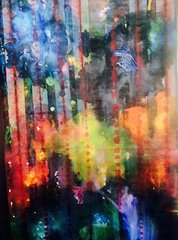 SOLD
SOLD
Botanical Spirits by Cheryl Edwards
Stain on Canvas
Size 30′” x 60″
Cheryl D. Edwards was born in Miami Beach, Florida. She began her studies in art during 1988 in New York City in a class at the Art Student League taught by the late, Ernest Crichlow. She has been living in Washington, DC for the past 18 years. Cheryl has exhibited in many shows in the Washington, DC, New York, Virginia, Maryland, Miami, Texas and Hong Kong. Her interest in art stems from her fascination of the human body as a whole. Her medium is oil, ink and acrylics. Please contact her for viewings and/or visit her website: Cheryl-edwards.artistwebsites.com. Currently represented by Artisan Direct, LLC(Rochester, NY) and Susanne Junggeburth Gallery (Germany).
Price $1,200
I Am
by Cheryl Edwards
Mixed Media
Size 17″ x 20″ Approx
Cheryl D. Edwards was born in Miami Beach, Florida. She began her studies in art during 1988 in New York City in a class at the Art Student League taught by the late, Ernest Crichlow. She has been living in Washington, DC for the past 18 years. Cheryl has exhibited in many shows in the Washington, DC, New York, Virginia, Maryland, Miami, Texas and Hong Kong. Her interest in art stems from her fascination of the human body as a whole. Her medium is oil, ink and acrylics. Please contact her for viewings and/or visit her website: Cheryl-edwards.artistwebsites.com. Currently represented by Artisan Direct, LLC(Rochester, NY) and Susanne Junggeburth Gallery (Germany).
Offered at $1,200

Make Offer – Ask Question
Extremely low offers will not be considered. Please do not make offers if you are not serious about buying this item.
An October Gallery ArtPro will respond to you as soon as possible.
If you prefer a telephone follow up, please leave your phone number.
SOLD
Bahiana
by Leila Ullmann
Original Oil on Canvas
Brazilian, born in Rio de Janeiro, formed an Integrated Schools Speech by Estacio de Sa, From a young age I dedicated to perform various forms of artistic expression, but only after retirement did I decide to devote myself entirely to art. SOLO EXHIBITIONS Seixas Cultural Center – June 2007 – RJ; German Alley – October and November/2007 – Barra da Tijuca -RJ; Gallery of Art and Science of Copacabana – Dec / January 2009 Exhibitions Abroad: Anuual 26th of October Gallery Philadelphia International -October/2011 – 6353 Greene Street, Philadelphia, PA 19144 -USA;